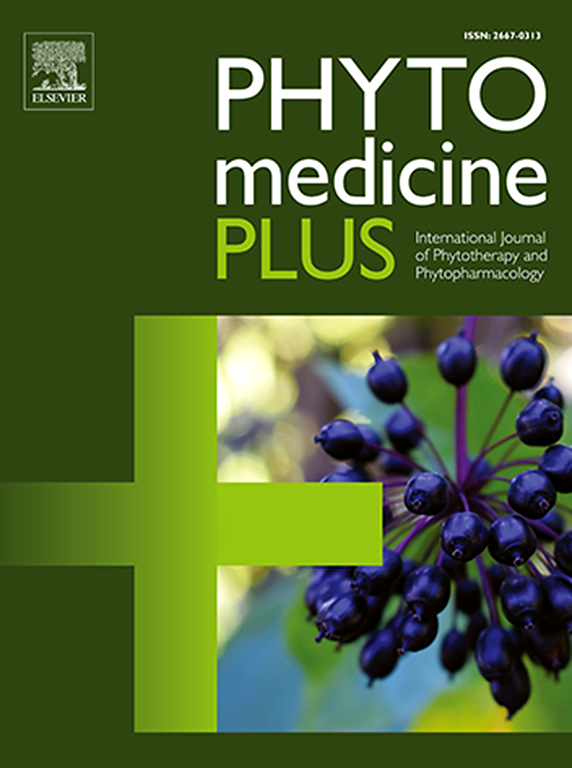Variability in bioactive compounds, antioxidant activity, and cytotoxicity assessment of diverse organs of Iranian oak (Quercus brantii Lindl.)
Q3 Pharmacology, Toxicology and Pharmaceutics
引用次数: 0
Abstract
The genus Quercus with over 1000 species is extensively dispersed throughout the temperate woodlands of the Northern Hemisphere and tropical climate zones. Numerous physiological functions, such as antibacterial, anti-inflammatory, liver-protective, gastroprotective, anticancer, antidiabetic, and antioxidant activities, have been documented and associated with the occurrence of bioactive compounds like phenolic acids, triterpenoids, and plant-based polyphenolic compounds. Given that different plant organs differ in terms of secondary metabolite production, this aim was to investigate the diversity of phytochemical compounds, antioxidant activity, and cytotoxicity of different parts of oak and its by-products. Total phenolic content varied between 50.4 to 125.3 mg GAE/g DW, with the maximum and minimum being in the gall and leaf. Fruit had the highest (68.3 mg RE/g DW) and the lowest (13.5) total flavonoid content in the gaz alafi. The highest (74.9 mg GAE/g DW) and minimum (8.9 mg GAE/g DW) total tannin were observed in the gall and gaz alafi, respectively. Gallic acid, salicylic acid, rosmarinic acid, 2,5-dihydroxybenzoic acid, chlorogenic acid, rutin, quercetin, caffeic acid, p-coumaric acid, and kaempferol were identified as the main phenolic compounds by HPLC-PDA analysis. Based on the results of the 3-(4,5-dimethylthiazol-2-yl)-2,5-diphenyl-2H-tetrazolium bromide (MTT) assay, no significant cytotoxicity was observed on normal cell line (HDF) and gastric cancer cells (MKN45). This study shows that different parts of oak and its by-products can be valuable sources of bioactive compounds and can be used in various therapeutic and industrial applications.
伊朗栎(Quercus brantii Lindl.)不同器官生物活性化合物、抗氧化活性和细胞毒性评价的变异
栎属有1000多种,广泛分布于北半球温带林地和热带气候带。许多生理功能,如抗菌、抗炎、保护肝脏、保护胃、抗癌、抗糖尿病和抗氧化活性,已被记录并与生物活性化合物如酚酸、三萜和植物性多酚化合物的发生有关。鉴于不同的植物器官在次生代谢物的产生方面存在差异,本研究的目的是研究橡树及其副产物不同部位的植物化学成分、抗氧化活性和细胞毒性的多样性。总酚含量在50.4 ~ 125.3 mg GAE/g DW之间变化,最高和最低的是胆和叶。总黄酮含量最高(68.3 mg RE/g DW),最低(13.5 mg RE/g DW)。总单宁含量最高的为74.9 mg GAE/g DW,最低的为8.9 mg GAE/g DW。HPLC-PDA分析鉴定没食子酸、水杨酸、迷迭香酸、2,5-二羟基苯甲酸、绿原酸、芦丁、槲皮素、咖啡酸、对香豆酸和山奈酚为主要酚类化合物。3-(4,5-二甲基噻唑-2-基)-2,5-二苯基- 2h -溴化四氮唑(MTT)试验结果显示,对正常细胞系(HDF)和胃癌细胞(MKN45)没有明显的细胞毒性。这项研究表明,橡树的不同部位及其副产品可以作为生物活性化合物的宝贵来源,并可用于各种治疗和工业应用。
本文章由计算机程序翻译,如有差异,请以英文原文为准。
求助全文
约1分钟内获得全文
求助全文
来源期刊

Phytomedicine Plus
Medicine-Complementary and Alternative Medicine
CiteScore
3.70
自引率
0.00%
发文量
178
审稿时长
81 days
期刊介绍:
 求助内容:
求助内容: 应助结果提醒方式:
应助结果提醒方式:


